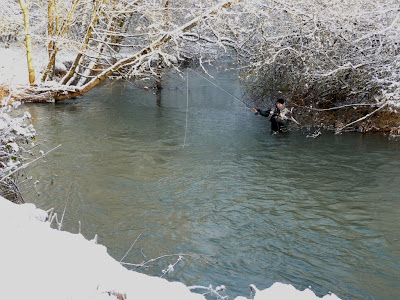 |
| The correct thermal layering is essential when deep water wading in winter! |
A good set of waterproofs and a well layered construction underneath can keep you warm throughout the day, often leading to you being called everything under the sun as your the last one off the water!
By layering up I don't mean throwing everything you own on and setting out fishing. Less layers with a good technical performance are more equipt at keeping you warm than 6 layers of t-shirts or 3 pairs of socks. A 3 layer system is the most effective. Base, Middle and Outer depending on the conditions your experiencing. Below is the perfect way to insulate your body to protect you against anything thrown at you.
Base Layer
Your base layer is the first layer of your winter protection and is the layer next to your skin. Getting your base layer correct is the key to retaining heat in any weather conditions. A quick moisture wicking material is ideal for keeping your garment from holding moisture such as sweat. This is vital for keeping you warm. It means if you sweat while fishing or walking your base layer will remain dry allowing you to stay warm.
The ideal base layer materials are merino wool, silk, polypropylene and other various synthetic fibres. If there is one rule to follow - never, ever use cotton as a base layer. It will not matter what you put over the top in an effort to keep warm, you will remain wet and cold.
You may wear light-weight, mid-weight, or heavy-weight base layers depending on the outside conditions. Use light-weight base layers for mild conditions and heavy-weight base layers for extremely cold weather conditions.
Mid Layer
The main purpose of the mid-layer is to provide your body with insulation. Its aim is to trap the warmth coming from your body, by trapping the warm air around your body. So make sure all your items fit correctly or your warm air will escape.
Tucking your layers in will help too! Your mid-layer goes over your moisture wicking base layer. You may need any number of mid-layers depending on the temperature you are experiencing.
A mid-layer should be thicker than a base layer. Again, do not use cotton it simply does not insulate as well as other fabrics. Some good examples of mid layers include a mid weight fleece or polyester.
You will find using several thinner mid-layer articles, like a vest, sweater or jacket, is better than one really thick and heavy garment. It will provide you with more flexibility if the weather change
Top Layer
This should be your thickest insulating layer and your warmest layer. There are many outer layers to choose from. When choosing an outer layer consider the following:
Temperature - Weight - Style - Purpose
An outer layer maybe a heavy fleece, a down jacket or soft shell. This is the layer that most people will see and will be in most of your photos when you get home.
A shell is your final layer. It is very important as it protects you from perspiration and wind. Essentially it is your water proof, wind proof layer which keeps all of your other layers warm and dry. Again there are many features of shells to be considered - weight, durability, length, warmth and waterproofing.
It can also be a good idea throughout the winter and the start of spring to use an additional 'bib and Brace' thermal underwear, which can be worn on top of your mid layers, putting the fleece and shell outside to retain the heat produced. These add much needed cold protection to your legs whilst wading in icy cold river, sitting still in a boat or on the bank of a still water.
Airflo Thermo Skin Bib and Brace has an effective wicking system which effectively transfers moisture away from the skin. The full body thermal suit retains heat from your ankles to your neck, paired with an effective fleece the cold will be sure to stay outside!
Interesting thoughts about clothing when it's cold. Here (Bollnäs, Sweden) it's to cold to fly fish during winter. Last night we had 25 degrees below zero centigrade and everything is frozen. But in early spring it would be wise to follow your suggestions.
ReplyDeleteHave fun keeping warm during fly fishing,
M.O.